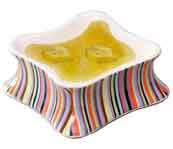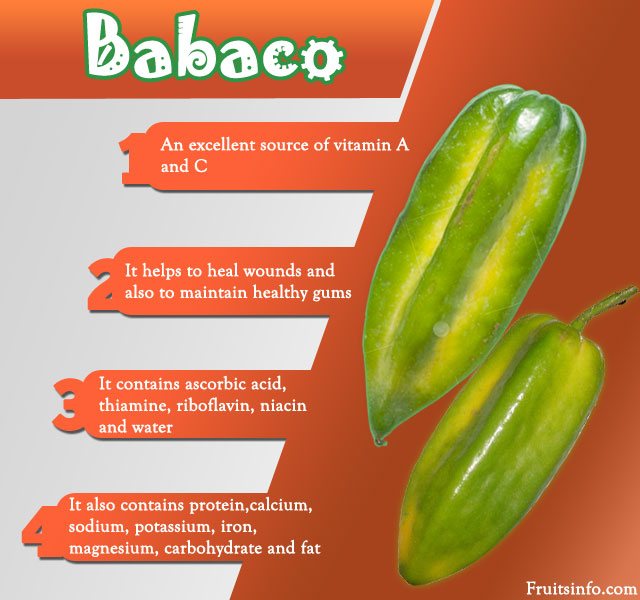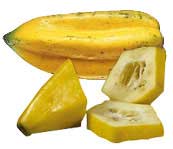 Full List of Fruits
Full List of Fruits  Babaco fruit
Babaco fruit
Babaco
Origin - The babaco is known to have originated in the central south highlands of Ecuador.
Scientific Name:Vasconcellea heilbornii
Appearance - Babaco is an attractive torpedo shaped fruit with an effervescent flesh hence it is also called the champagne fruit . When sliced crosswise, the facets of this fruit gives a pentagonal outline which gives it the scientific name of Carica pentagona. The texture of this golden fruit is very light and refreshing. The babaco fruit is just like a papaw with a single, knobbly stem dividing into two or more branches at the top. It bears a few large, sparse flowers and lobed leaves which forms on the trunk and branches.
Babáco is best eaten raw. It contains three times the amount of papain as in papaya and is considered as an excellent source of vitamin A and C. Our body needs vitamin C which mainly helps to heal wounds and also to maintain healthy gums.
| Vitamins (100g of babaco) | |
| Ascorbic acid | 23-32 mg |
| Vitamin B1 (thiamine) | 0.02 - 0.03 mg |
| Riboflavin | 0.02 - 0.06 mg |
| Niacin | 0.5 - 1.1 mg |
| Vitamin A | 0.16-2.0 IU |
| Vitamin C | 23 mg |
| Minerals (100g of babaco) | |
| Phosphorus | 7.7 - 17.1 mg |
| Calcium | 8 - 12.1 mg |
| Sodium | 1.3 - 3.0 mg |
| Potassium | 132 - 220 mg |
| Iron | 0.3 - 4.2 mg |
| Magnesium | 6.0 - 15.4 mg |
| Carbohydrate | 4.6 - 6.0 g |
| Lipid(fat) | 0.02 - 0.3 g |
| Protein | 0.7 - 1.3 g |
| Water | 93 - 94 g |
1) The capacity of a matured babaco tree is nearly between 38 to 100 fruits per year.
2) Fruits are harvested only when they lose their green colour and turn yellow all over.
3) Babacos require a very warm, humid climate and perfect drainage. They are not tolerant to strong winds and hot dry conditions.
4) All babacos are female and do not require pollination, which means all the fruits are seedless.
5) The babaco plant has an average life span of about eight years.
6) The babaco plant is damaged by air frost, and sometimes will be killed in severe air frosts.
7) Babaco fruits may get damaged easily, hence it should be handled very carefully.
Babacos are remarkably tough and disease-resistant. They are very susceptible to root rot diseases when they become saturated with water or full of water. Severe root rot diseases in babacos can only be treated by chopping down the plant and either treating the soil with a fungicide or,chopping out the whole root system and leaving the ground empty by without planting any other fruit tree there for at least a year.
Prolonged humidity can also bring on powdery mildew, which coats the leaves in a pale, powdery substance. This can be easily treated with either milk sprays (one part milk to 10 parts water) every 10 days or a commercial brand remedy. Prevention is always better than cure -good drainage, plenty of light, and good air circulation around the plants will prevent the trees from the occurence of such problems. Babacos need humidity to set fruit. Crowding them to together may cause the fungal problems to develop.
The major pests affecting the babaco fruit and the tree are the
- Two spotted mite - Tetranychus uraticae
- Strawberry mite - Tetranychus atlanticus
How to buy fresh Babacoes?
To get the full Nutrients, babaco should be eaten when completely ripe, hence look for fruit that are completely yellow in colour, with no such green patches over it. The skin of the babaco should be smooth with no splits or blemishes on it. Once ripe, consume babacoes as soon as possible, or store it in the fridge for a maximum of 2 to 3 days.The babaco's skin is edible, so all you need to do is wash and dry the fruit before consuming. It will ripen quickly at room temperature, especially if placed in a brown paper bag. Refrigerate ripe fruit and consume it as soon as possible. The fruit is not especially acidic but contains papain, a proteolytic enzyme, which may cause mild irritation or "burns".
Despite this one of the most attractive features of the babaco is its excellent storage quality. Even without cool storage the fruit has a shelf-life of four weeks. Fruit that has been damaged will still keep a long time, since the damaged part will not affect the healthy tissue. Storing the fruit in a cool place extends the life of the fruit. Optimum storage temperature is 40° F.
Look for : Look for fruit that are completely yellow in colour, with no green patches. Their skin should be smooth with no splits or blemishes.
Avoid : Fruit once ripen should be used as soon as possible if not, the proteolytic enzyme present in it may cause mild irritation or "burns" on the skin.
- 25 Mint Leaves
- 1 Fresh green chilli, chopped
- 1 tbsp white cummin seeds
- 1 tbsp Mustard seeds
- Salt, as required
- Water, as required
- 4 sm Ripe Babacos

Method:
- Wash the babacoes, Slice into rings or lengths, remove the seeds and cut it into pieces.
- Put the babacoes, together with the mint leaves, green chillies, cumin seeds, mustard seeds and salt, into a mortar, and pound with the pestle (or use a sil-batta) into a pulp.
- Add water as needed to thin the chutney to the desired consistency.
- Refrigerate and serve.

Ingredients:
- 1 whole babaco
- 1 – 2 cups of white sugar
- Water as needed
- 1 stick of cinnamon
- 2 glass of orange juice
Method:
- Wash the babacoes, peel it off and cut it into pieces.
- Put all the ingredients in a large vessel and let boil on medium heat for 30 minutes, stir it occasionally.
- Remove the cinnamon stick and let cool.
- Refrigerate the unused portions for up to five days.

















